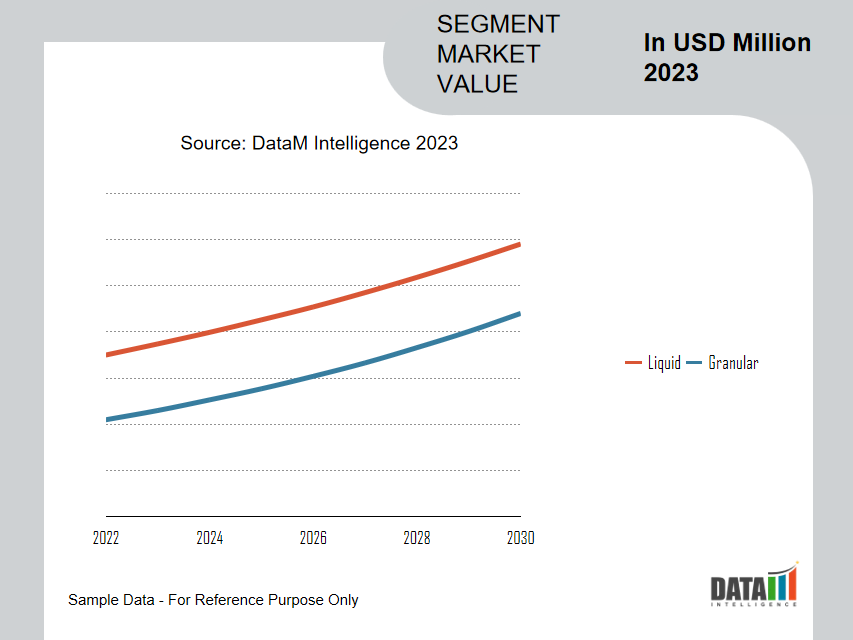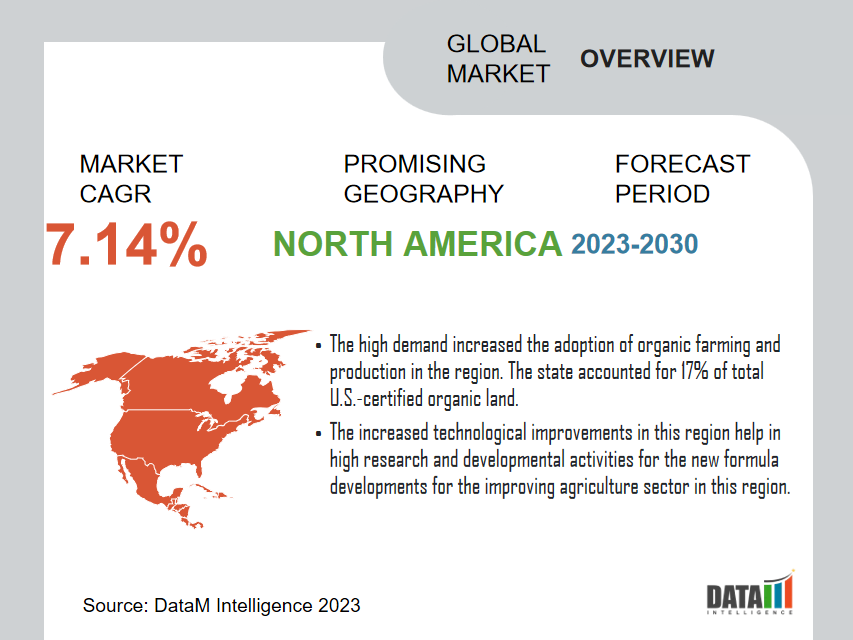Plant Bio-Stimulants Market Size
Global Plant biostimulants market reached US$1.89 billion in 2022 and is expected to reach US$3.05 billion by 2031, growing with a CAGR of 6.2% during the forecast period 2024-2031, according to DataM Intelligence report.
Plant bio-stimulants are composed of various ingredients such as acids, microbial, extracts, and others proving beneficial properties to plant growth. The plant bio-stimulants are available in liquid and granule forms and can be applied to plants, soil or seeds. They are suitable for different crop types, including cereals & grains, oilseeds & pulses, fruits & vegetables, and flowers & ornamentals, enhancing plant nutrition.
Plant bio-stimulants can be applied through foliar treatment, soil treatment, or seed treatment. They include various formulations of micro-nutrients to improve both plant and soil qualities. Plant bio-stimulants have a major impact on the crop's development. According to EBIC 2021, 5-10% of the minimum yield increased with the use of biostimulants.
North America dominated the global plant bio-stimulants with the high demand for organic farming and sustainable agricultural practices. According to USDA, NASS highlights, that U.S. farms and ranches sold $11.2 billion in certified organic commodities in 2021, out of which 54% was for crops. The number of certified organic farms with organic production in the U.S. and certified organic cropland increased by 3%.
Market Summary
| Metrics | Details |
| CAGR | 6.2% |
| Size Available for Years | 2022-2031 |
| Forecast Period | 2024-2031 |
| Data Availability | Value (US$) |
| Segments Covered | Ingredient, Form, Substrate, Crop Type, Mode of Application and Region |
| Regions Covered | North America, Europe, Asia-Pacific, South America, and Middle East & Africa |
| Fastest Growing Region | Asia-Pacific |
| Largest Region | North America |
| Report Insights Covered | Competitive Landscape Analysis, Company Profile Analysis, Market Size, Share, Growth, Demand, Recent Developments, Mergers and Acquisitions, New Product Launches, Growth Strategies, Revenue Analysis, Porter’s Analysis, Pricing Analysis, Regulatory Analysis, Supply-Chain Analysis and Other key Insights. |
For more details on this report– Request for Sample
Plant Bio-Stimulants Market Dynamics
High Benefits of Plant Bio-Stimulants
Biostimulants have several benefits for their popularity among the global farmers. They increase nutrient use efficiency which helps farmers get a better return on their investment in fertilizers. Biostimulants use nutrients in the soil, resulting in phosphorus solubilization, thus reducing nutrient losses. Good nutrition is essential for high yields, and biostimulants play a crucial role in improving nutrient use, which in turn enhances yield and quality.
Biostimulants also help plants tolerate abiotic stresses such as drought, extreme temperatures, and flooding, and help plants cope better in the face of stress. These bio-stimulants improve the yield of their use. Improving root development is another benefit of biostimulants. They improve water use efficiency, which often helps improve yields. Researchers found the various benefits of the plant bio-stimulants through field trials. Various plant biostimulant products have different levels of impact on the crops.
High Interest of Manufacturers in Research And Development
Growers are responding to consumer demands for healthier food products with minimal environmental impacts by finding ways to use synthetic chemicals and mineral fertilisers more efficiently and effectively. The major players of the plant bio-stimulant are expanding their networks and connecting by developing innovative products to cater to specific agricultural needs, attracting new customers.
According to EBIC's survey, most companies invest 3% and 10% of their annual turnover in research and development. On the other hand, some of them reinvest an even higher share in innovation. It is being reported that most companies have between 10% and 33% of staff involved in R&D activities. The high interest of the manufacturers for a better solution improvement help in expanding the market growth.
High Cost and Presence of Alternatives
The global plant bio-stimulants market is restrained by the high costs of the product compared to conventional alternatives available in the market. Traditional fertilizers and pesticides are less expensive compared to those of plant bio-stimulants, making them expensive for price-sensitive end-users.
The price sensitivity and lack of awareness among the growers resulted in increasing the popularity of other alternative products such as synthetic fertilizers and pesticides that are widely available in the global market. The pesticides and fertilizers market has been well established for ages and is one of the high competition for plant bio-stimulants, hindering its growth.
Plant Bio-Stimulants Market Segmentation Analysis
The global plant bio-stimulants market is segmented based on ingredient, form, substrate, crop type, mode of application and region.

Faster Absorption and Rapid Results of the Liquid Plant Bio-Stimulants
The global plant bio-stimulants market is segmented based form into liquid and granules. The liquid segment accounted for the largest share of the global market due to the high preference for the product by the farmer and grower. The convenience and ease of use of these biostimulants make them popular among producers for rapid results.
The liquid plant bio-stimulants are highly preferred for the foliar application. The ease of application and faster absorption make them readily available for plant uptake, resulting in quick results. The liquid form the plant bio-stimulants performs more consistent and uniform application, improving efficiency due to their high concentration and bioavailability.
Plant Bio-Stimulants Market Geographical Share

Increasing Demand for Organic and Sustainable Agriculture Practices in North America
Biostimulant use is becoming more widespread globally. North America dominated the global plant bio-stimulants market, due to high demand for environmentally friendly practices. The rising demand for organic products is directly influencing the growth of organic farming enhancing the plant yield and meeting the consumer demand for sustainable practices.
The high demand increased the adoption of organic farming and production in the region. According to USDA NASS highlights 2021, California led in both the number of farms and acres, with 3,061 organic certified farms and 813,710 acres. The state accounted for 17% of total U.S.-certified organic land.
Many collaborations and partnerships expanded the regional market. In May 2022, UPL, a global leader in sustainable agriculture solutions, partnered with Kimitec's MAAVI Innovation through its Natural Plant Protection business unit. This strategic collaboration aims to deliver tailored BioSolutions technologies in the United States. The increasing demand for high-value crops and organic agriculture fuels the need for such technologies.
In North America, bio-stimulants are used not only in organic production, but high-value fruit and vegetable crops nut is also expanding into conventional crop production. The increased technological improvements in this region help in high research and developmental activities for the new formula developments for the improving agriculture sector in this region.
Plant Bio-Stimulants Market Key Players
Key players are Arysta Lifescience Corporation, BASF SE, Biochim S.P.A, Biostadt India Limited, Gowan Company, Koppert, Hello Nature International Srl, Trade Corporation International, Valagro and Bayer Crop Science.
COVID-19 Impact
The COVID-19 pandemic negatively impacted the whole agriculture industry. The plant bio-stimulants market also faced several challenges due to the sudden pandemic breakthrough. The disruption in the supply chain activities badly influenced the exchange of the products in the market. The halt in the distribution channel activities delayed the reach of the products to the end-user.
The pandemic increased health and environmental concerns among consumers. The rise in consumer awareness regarding the adverse effects associated with the utilisation of fertilisers and pesticides increased the market demand for organic and sustainable agricultural practises driving the market growth in the period.
Key Developments
- In November 2023, Yara announced the launch of YaraAmplix, a new brand of biostimulants. The product was launched at the Biostimulant World Congress in Italy.
- In July 2023, Bionema Group Ltd, a leading biocontrol technology developer and manufacturer, announced the launch of a new range of biostimulants into the market.
- In May 2022, UPL, a global leader in sustainable agriculture solutions, partnered with Kimitec's MAAVI Innovation through its Natural Plant Protection business unit. This strategic collaboration aims to deliver tailored BioSolutions technologies in the United States.
Why Purchase the Report?
- To visualize the global plant bio-stimulants market segmentation based on ingredient, form, substrate, crop type, mode of application and region, as well as understand key commercial assets and players.
- Identify commercial opportunities by analyzing trends and co-development.
- Excel data sheet with numerous data points of plant bio-stimulants market-level with all segments.
- PDF report consists of a comprehensive analysis after exhaustive qualitative interviews and an in-depth study.
- Product mapping available as excel consisting of key products of all the major players.
The global plant bio-stimulants market report would provide approximately 78 tables, 75 figures and 224 pages.
Target Audience 2024
- Manufacturers/ Buyers
- Industry Investors/Investment Bankers
- Research Professionals
- Emerging Companies